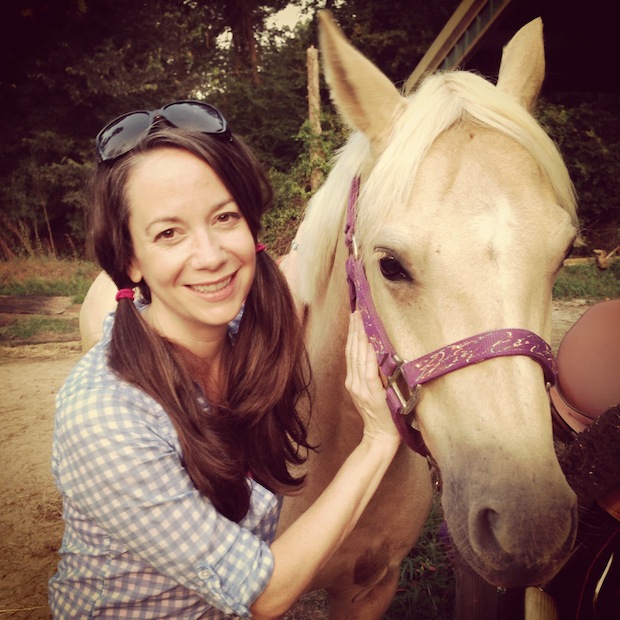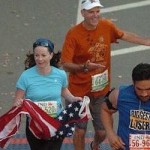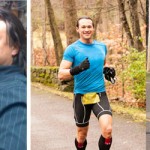The Best Workout Buddies
 Things that look easy usually aren’t, but sometimes achieving that effortless appearance can be a great workout.
Things that look easy usually aren’t, but sometimes achieving that effortless appearance can be a great workout.
Such is the case with horseback riding, which my wall-climbing friends Melissa and Tina and I found out recently with a trip to Midland Farm, south of Little Rock in Alexander. Our beginner lesson with Melanie, the stable’s owner, taught all of us that a lot is going on when we see people galloping over the plains or jumping fences or hedgerows—a lot of core and inner thigh work, to be exact.
“Horseback riding seems so effortless,” said Melissa the day after our lesson. “But when you are on the horse, so much of your body is engaged: Your heels are down, your thighs are actively working to keep you in place, and your core is tight to keep your balance.”
The lesson included more than just riding. We did everything from brushing the horses before and saddling them up, to basics in the riding ring. After we were done with our ride, we unsaddled them and brushed them down. For the three of us animal lovers, it was a real plus to spend time caring for our horses. We learned how to scrape out their feet, fasten their saddles, bridles and girths and walk around them. I fell a little in love with Banana Pancakes, my mount.
Melanie was an educational host. She talked to us about our horses, their care, their tendencies and how to manage them from the moment we arrived. I’m a learner, and I like to know as much as I can about any topic I’m engaged in, so this was fascinating for me.
She chose our horses for us by our riding experience. We ranged from Melissa, whose stepmother raised horses, giving her the most experience, to Tina, with none. (“No trail rides ever?! ” Melissa and I asked her incredulously.) I’d been to a Girl Scout Riding camp in junior high, and Jay and I like go horseback riding when we can on vacations. I’ve got enough experience to know how to get into the saddle, but not enough to be unafraid of the horses.
They are, after all, very big.
Our mounts ranged from 750 to nearly 1,000 pounds. And this is where Melanie’s tutorial was really helpful. She taught us how to walk around the back of a horse (stay close and touch the animal so he or she knows where you are) and described how horses think and react so we could understand and work to prevent any issues. For example, horses are historically prey animals, which is why they shy at sudden movements. As we rode in the ring at dusk, Melanie guided us away from the shadows to prevent spooking.
We rode for about an hour or so in the ring, around and around, mostly walking, but it wasn’t boring. For one thing, Melanie was talking to us about our horses, what we needed to be doing and what we’d have to learn to progress as riders to go faster than a trot. She gave us little challenges, such as to try standing up in the saddle all the way around the ring, or for as long as we could (it’s harder than it seems), as riders who want to learn to jump must have this kind of core and leg strength and balance to be safe over the rails.
Tina appreciated specifically that we weren’t overwhelmed with information, but when we asked a question, we got a well-informed answer from a clearly experienced teacher. “I could apply her answers immediately,” she said.
Melissa, with her greater experience, was allowed to trot off a lead, but Tina and I trotted with Melanie holding a rope, and our horses trotted in a circle around her. She taught us the one-two rhythm of the trot, stand up-one, sit down-two, which also took a lot of leg and core strength… plus rhythm.
“I didn’t feel like I was exerting too much energy until I started to trot,” said Melissa, but when she began that gait with her horse, she immediately started breathing and working harder. “It was like I was the one starting to jog, not Princeton.”
Tina agreed about the workout, saying she was surprised to be sweating when it was Blaze who was running.
As I rode, trying to stand for sustained periods, or stand and sit on the trot one-two, I found myself calling a great deal on my yoga-developed abilities, such as they are, of balance and core strength. The next day, my inner thighs and gluts were a little sore, which let me know I’d worked them in new ways.
I think my favorite thing about the lesson, which was $35 each, beyond even the education of working with Melanie and the great strengthening and coordination opportunities, was being with the horse. I love animals, and I found the interaction with Banana Pancakes (Nanners!, as I called her) calming and centering. I felt camaraderie with her as I moved her around the ring, trotted and brushed her down. I imagine it’s not unlike running with my dog, to be out together, enjoying the day, moving and focusing on the here and now.
That focus is the difference, which Tina noted. “I felt more mentally engaged. Horseback riding isn’t like running, where you can just zone out to calculate your calories to justify that cookie later,” she said. “You had to be there, in the moment, because you were sitting on top of an 850-pound animal with a mind of its own.”
Tina said it was a challenge to remember not only her posture and position, but also to get her head into a confident space, so she could command the beautiful creature she was paired with.
“It’s a funny paradox,” she said. “On the outside your body has to remain upright, strong and mostly rigid, but on the inside, being relaxed, calm and in control is key.”
We all recommend such lessons as a workout. It’s not the heaviest or most demanding fitness activity you can do, but it may be one of the most centering because you must be present with the animal who is carrying you—and you’ll want to be.













